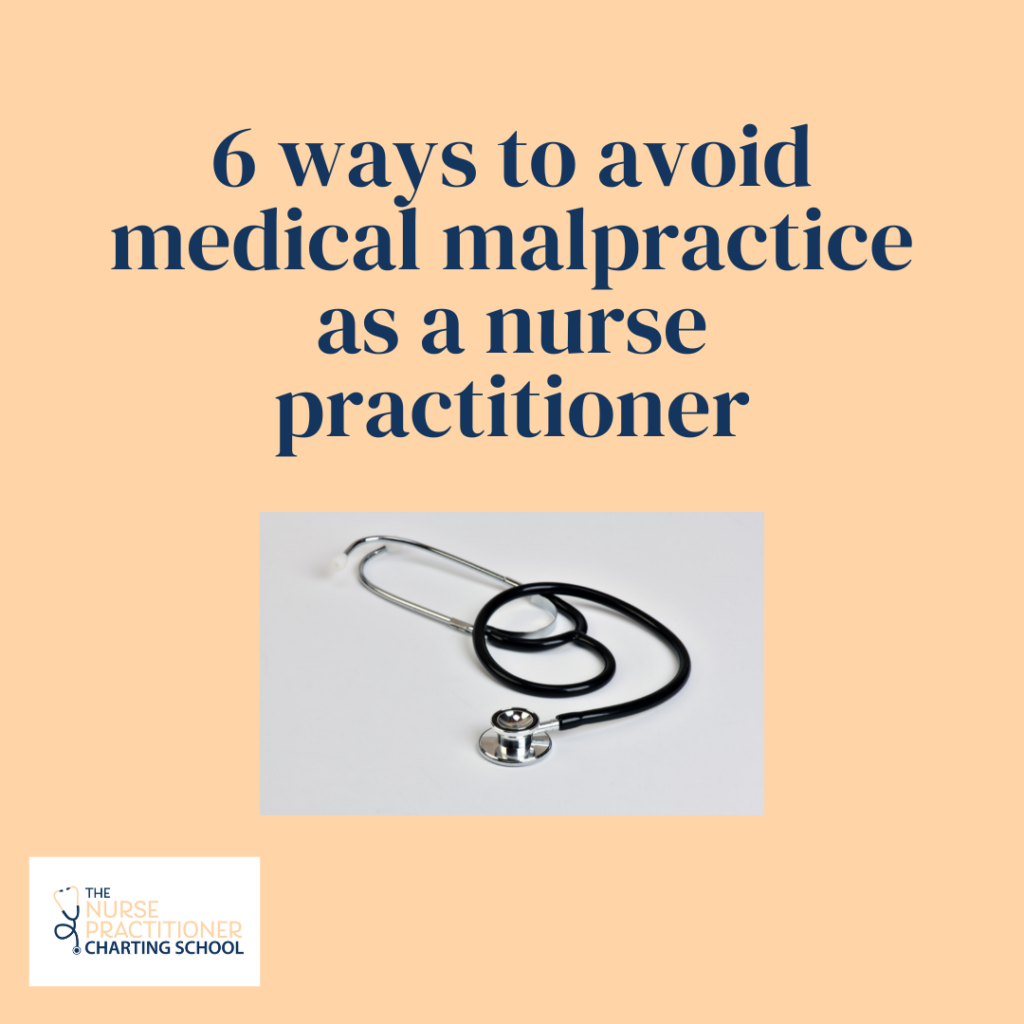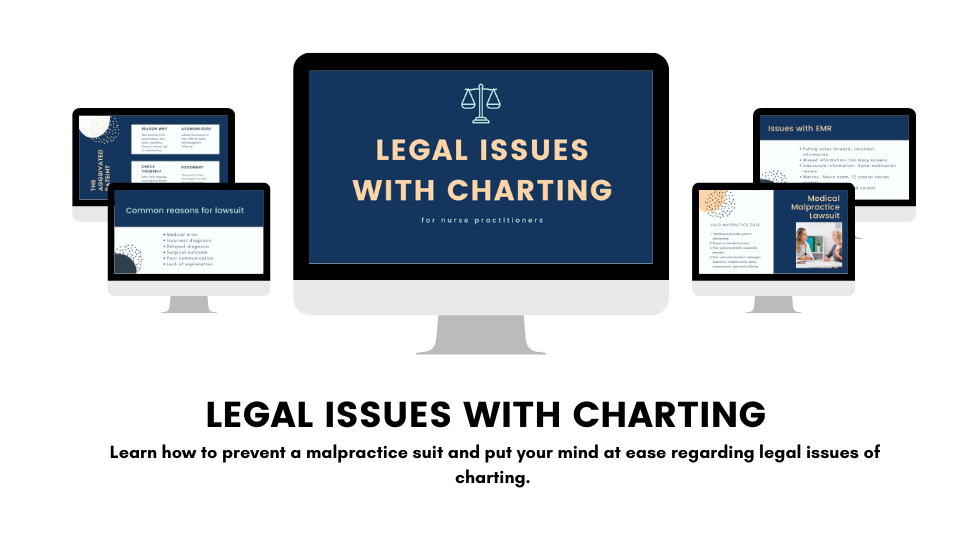As a nurse practitioner, providing quality care to patients is of utmost importance. However, the complex nature of healthcare can pose risks, and medical malpractice lawsuits are a concern for nurse practitioners.
APRNs are not immune to a medical malpractice suit. Sometimes the nurse practitioner is in the wrong place at the wrong time. Sometimes a patient will have an abnormal presentation or a rare condition that is difficult to diagnose.
Therefore, to safeguard your professional reputation and ensure patient safety, it’s crucial to adopt strategies that minimize the likelihood of facing a lawsuit. In this blog post, we will explore key tips to avoid medical malpractice as a nurse practitioner. We will discuss focusing on communication, documentation, continuous education, collaboration, and maintaining ethical standards.
Effective communication
Clear and effective communication is the foundation of successful healthcare delivery. As a nurse practitioner, it’s essential to establish strong lines of communication with patients, their families, and other healthcare team members. Consider the following tips to avoid medical malpractice as a nurse practitioner.
Active listening.
Pay close attention to patients’ concerns, symptoms, and medical history. Encourage them to express their thoughts and ask questions. One of the main reasons patients sue is due to a lack of communication and not feeling heard by the healthcare provider. Taking the extra minute to listen to the patient’s concerns can help avoid medical malpractice as a nurse practitioner.
Clear explanations.
Use plain language to explain diagnoses, treatment plans, and potential risks involved. Ensure patients understand and are actively involved in decision-making. Allow patients and family members to ask questions to achieve clarity.
Written instructions.
Provide written instructions, including medication details, follow-up appointments, and any necessary lifestyle modifications. This will help the patient to remember the instructions and also shows proof that the nurse practitioner provided education/instructions.
Timely follow-up.
Stay in touch with patients, monitor their progress, and promptly address any concerns or changes in their condition. There are often malpractice cases that involve a delayed diagnosis or failure to ensure the patient follows-up. Do your best to ensure the patient follows-up and make sure to document each time the patient was contacted.
Comprehensive documentation
Accurate and thorough documentation is crucial to defend against medical malpractice claims. Develop good documentation habits to support your clinical decision-making and actions. For more tips check out The NP Charting School’s online course: Legal Issues with Charting.
Timeliness.
Document all patient encounters, treatments, prescriptions, and discussions as soon as possible after the event occurs. Avoid going back to edit a chart note, especially if you know the patient had a negative outcome.
If it is necessary to add additional information, do so through an addendum to the note and explain the reasons for the late entry. Ensuring timeliness of completing chart notes helps to avoid medical malpractice as a nurse practitioner.
Objective language.
Use clear, concise, and objective language when documenting patient assessments, interventions, and outcomes. Avoid subjective statements or personal opinions. Keep chart notes professional to avoid medical malpractice as a nurse practitioner.
Include rationale.
Explain the clinical reasoning behind your decisions, treatment plans, and any deviations from standard protocols. I make sure to explain rationale when I am unsure of the exact diagnosis.
For example, if I evaluated a patient for abdominal pain I will make sure to explain any pertinent positives/negatives (i.e. denies fevers, no vomiting, no blood in stools) and need for additional workup.
Follow policies and guidelines.
Familiarize yourself with organizational policies and guidelines regarding documentation and adhere to them consistently. This will ensure quality patient care and help avoid medical malpractice as a nurse practitioner.
Continuous education and professional development
Medical knowledge is constantly evolving, and as an NP, it’s essential to stay updated. Continuous education helps you provide evidence-based care and minimize the risk of medical errors and avoid medical malpractice as a nurse practitioner.
Attend conferences and workshops.
Participate in professional conferences, workshops, and seminars to stay informed about the latest research, guidelines, and advancements in your field.
Read professional journals.
Regularly review reputable medical journals to stay current on emerging research and best practices. Ensuring you are staying up-to-date with current clinical practice guidelines and help avoid medical malpractice as a nurse practitioner.
Seek mentoring.
Establish a relationship with an experienced nurse practitioner or other healthcare providers who can guide and support your professional growth. Healthcare is ever changing and we are not expected to know everything. Finding a mentor can help you and avoid medical malpractice as a nurse practitioner.
For 1 to 1 support as a nurse practitioner check out The Burned-out Nurse Practitioner’s coaching session offer.
Collaborative approach
Promoting collaboration among healthcare professionals fosters a team-based approach to patient care. Nurse practitioners should identify their own personal and professional limitations. Healthcare is a vast field with treatments and clinical practice guidelines that are always changing. We should acknowledge this and not be afraid to have a collaborative approach when caring for patients.
Effective communication with colleagues.
Communicate openly and effectively with physicians, nurses, and other healthcare providers involved in patient care. Share critical information and seek their input when necessary. This will help avoid medical malpractice as a nurse practitioner.
Consultations and referrals.
Recognize your limitations and consult or refer patients to specialists when needed. Collaboration ensures patients receive comprehensive and specialized care.
Multidisciplinary teamwork.
Embrace a multidisciplinary approach by involving other healthcare professionals in decision-making and patient management. This promotes holistic care, reduces the likelihood of errors, and helps avoid medical malpractice as a nurse practitioner.
Uphold ethical standards
Maintaining high ethical standards is fundamental to providing safe and compassionate care. Nurse practitioners should provide the quality of care they want their family members to receive.
Respect patient autonomy.
Respect patients’ right to make informed decisions about their healthcare. Obtain informed consent for procedures and treatments to avoid medical malpractice as a nurse practitioner.
Complete patient centered care.
Nurse practitioners are good at looking at the holistic patient and providing quality patient care. This is an important concept when it comes to legal issues with nurse practitioner practice.
More tips to avoid medical malpractice
As previously mentioned, nurse practitioners are not immune to a medical malpractice suit. Sometimes the APRN is in the wrong place at the wrong time. But utilize these tips for doing your best to avoid a negative outcome of a medical malpractice case.
To learn more about avoiding a negative medical malpractice case, check out Legal Issues with Charting.
This online, self-study course will teach you
- Common reasons healthcare providers get sued.
- What actually makes a valid malpractice case.
- The steps of a malpractice case.
- Charting tips and wording to use/avoid to prevent a malpractice case.
Plus an exclusive presentation from a Legal Nurse Consultant!
Elisa Collins, MSN, APRN, FNP-C, ALNC, NP-CL shares her knowledge of healthcare and malpractice cases! Elisa gives applicable tips for NPs to protect themselves through clinical and documentation practices.
In this sixty minute presentation: Mitigating Your Liability Through Strategic Documentation
Elisa breaks down:
- Percentage of cases that actually go to court
- Discussion of most commonly litigated conditions (you need to know this!)
- Do’s and Don’ts of documentation to protect yourself
- And so much more!
Learn how to prevent a malpractice case and put your mind at ease by investing in
The Legal Issues with Charting Course

Erica D the NP is a family nurse practitioner and The Nurse Practitioner Charting Coach. Erica helps nurse practitioners STOP charting at home! Erica created The Nurse Practitioner Charting School to be the one stop for all documentation resources created specifically for nurse practitioners. Learn more at www.npchartingschool.com
Follow on Facebook: The Nurse Practitioner Charting SchoolAnd on Instagram: @npchartingschool
Free training: 4 charting tips to help nurse practitioners get their time back! Sign up here!




